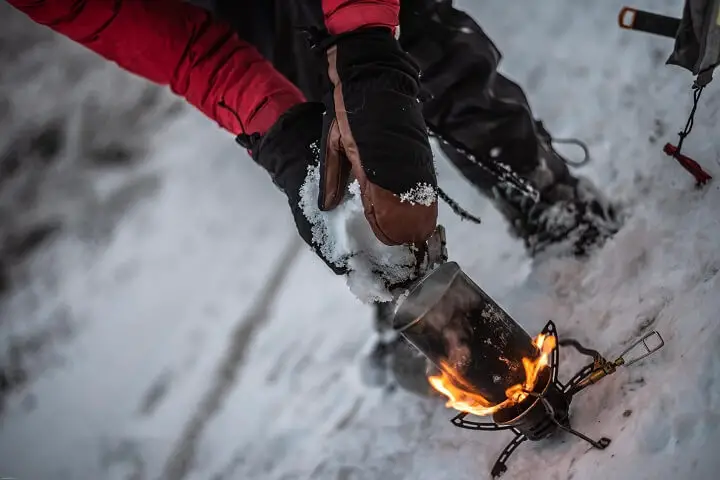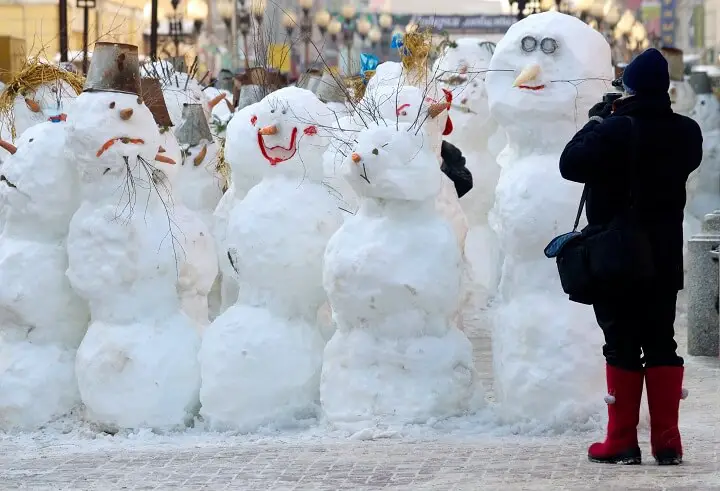[ad_1]

About 1,330 people die of exposure to cold each year in the United States, according to a study published by the National Institute of Health. While you might picture people freezing to death on rugged mountain trails, many people die of hypothermia in urban areas too. The actual number of cold weather-related deaths may be under-reported since winter weather can worsen respiratory illnesses or heart disease conditions.
Want to save this post for later? Click Here to Pin It On Pinterest!
According to the Centers for Disease Control (CDC), the most common cold-related illnesses include hypothermia (dangerously low body temperature), frostbite (loss of feeling and color in the affected areas), chilblains (painful inflammation of blood vessels in the skin), and trench foot (foot injury resulting from extended exposure to cold and wet conditions). If left untreated, each of these conditions can lead to serious injury and even death.
Preparation is the key to winter survival. Here are 20 supplies you need to have to ride out a storm or power outage this winter.
1. Alternate Power Source
Blizzards, ice, and heavy snowfalls can knock out power lines. If you live in an area where this is a typical winter occurrence, you may already have invested in a back-up generator.
Other less-expensive options include small portable power stations like this one which will help you keep your phone and other small electronics charged. Another option is to purchase a power inverter cord that connects to your car battery. These are available at most auto supply retailers.
2. Hand Crank Radio And Flashlight
This handy device will keep you up-to-date with weather information and give you some light while you listen. And you won’t need to run down your power source to use it.
3. Water Supply
Having enough water is essential, whether you are snowed in at your home or in your vehicle. Keep jugs of water stored in both places this winter. During a power outage, a small camp stove can be useful for melting snow and ice.
4. Flashlights, Candles, and Flares
Check your supply of flashlight batteries and keep plenty of candles and matches at home. Store flares in your car for road emergencies, and you may want to consider a hand-cranked or solar-powered flashlight as well.
5. Extra Blankets
When the cold is on and the heat is off, you’ll need more blankets to stay warm. Have extra cozy blankets for everyone in your household and keep emergency blankets in your car. Mylar blankets like these are small and lightweight but can keep you warm in an emergency. They’re also waterproof, and they help retain body heat.
6. Shovel
Have a shovel or two on hand at home to help you dig out your car and clear walkways. It’s also useful to clear your car’s exhaust pipe if it gets blocked by snow and ice. Consider a folding shovel for your car to help dig your way out of an unexpected snowfall.
7. Kitty Litter or a Bag Of Sand
Your tires need traction when the road or driveway gets icy. Other options include traction boards like these and zip-tie grippers like these. If you live in or near an area that usually gets a lot of snowfall, then snow tires are often a necessity. Make sure your set is in good condition.
8. Ice Melt
These products melt show on sidewalks and other areas. Most of them are dangerous for pets and other animals. If you have furry friends, look for an ice melting product that is safe for animals like this one.
9. Windshield Scraper
Have windshield brushes and scrapers at the ready in each of your vehicles so that you can see safely enough to drive. You’ll find lots of options here.
10. Car Antifreeze
Antifreeze helps regulate your car engine during extreme temperatures. It helps prevent engine corrosion. Be sure to check your antifreeze levels throughout the winter, so your vehicle keeps running smoothly.
11. Windshield Fluid
Driving past other cars and trucks during the winter can be a dirty business. Dirty road slush can pile up on your windshield, making good visibility a problem. Keep your windshield fluid reservoir full all year round.
12. Window Coverings and Draft Sealants
Winter weatherize your home by checking for drafty spots around doors and windows. Here’s a video that offers some inexpensive ideas for insulating windows with bubble wrap, plastic sheeting, painter’s tape, and cardboard.
13. Propane Space Heater
If you don’t have a wood stove, a propane space heater provides a way to heat your home in a power outage. These heaters come in many sizes and price ranges. This one is a portable radiant heater for spaces up to 225 square feet. It is suitable for indoor and outdoor use.
14. Chainsaw
Do you have trees on your property? Snow and ice can bring down huge limbs and branches and even entire trees, causing hazards and blocked access. A chainsaw will come in handy to clear the way and is useful for cutting firewood for your wood-burning fireplace. If you’ve never bought a chainsaw before, here is a helpful buying guide from Consumer Reports.
15. Ax
An ax is useful for chopping and splitting wood for your wood stove or fireplace. If you don’t usually rely on wood for all your home’s heat, plan to keep extra wood on hand for power outages.
16. Snow Gear and Insulated Clothing
Frostbite is no joke. The fingers and toes are especially susceptible, but any exposed skin can become damaged in severely cold temperatures. Mild cases respond to gradual warming, but severe cases require medical care. Waterproof pants, jackets, boots, gloves, warm socks, and hats are cold-weather essentials. Cover your mouth to protect your lungs.
17. Sunglasses
Sunglasses are not just for the summer. Your eyes need protection when you are driving or working in sunny, snowy conditions.
18. Food
Keep a supply of nutritious, ready-to-eat, calorie-dense foods on hand in case you get stuck without power. Dried fruit, nuts, and granola bars are a few options. Be sure to have a hand-operated can opener for ready-to-eat canned goods. Don’t forget your pets and livestock when building your emergency food supply.
19. First Aid Kit
You should have a well-stocked first-aid kit at home and in your vehicles. In addition to standard supplies like bandages, gauze pads, medical tape, antibiotic ointment, tweezers, and pain relievers, add the following cold weather first aid supplies:
20. Jumper Cables
Winter is tough on car batteries. Be sure to have a set of jumper cables in your vehicle to offer help to a stranded motorist or receive the aid of another driver if your battery is dead.
Here are some other tips for winter safety preparedness:
- Check your tire pressure during cold weather. Tire pressure can decrease about 1 PSI (pound per square inch) for every 10 degrees the temperature drops. As the air inside the tire condenses, it takes up up less space.
- Keep your fuel tank more than half full in cold weather. Why? In the winter, condensation in your gas tank can freeze and then block your fuel line. Keeping a fuel tank also is a good idea in case you need to make an emergency trip.
- Dress in layers of loose, warm clothing.
- Prevent the loss of body heat by wearing a warm hat that covers your ears.
- Avoid remote routes — even if your GPS tells you to go that way — unless you are familiar with current road conditions.
- When driving, increase the distance between your vehicle and the vehicle in front of you.
- Test your home’s smoke alarms and carbon monoxide detectors. Each year more than 400 Americans die from accidental carbon monoxide poisoning, according to the CDC. More than 4,000 others are hospitalized.
Now, if you’re wondering just how bad the winter of 2020-2021 will be, the venerable Old Farmers’ Almanac has published its forecast. The magazine, which has been in publication since 1792, predicts that warming trends will dominate in the eastern and northern parts of the United States, with below-normal temperatures limited to the western half of the country.
The Almanac forecasts snow levels to be greater than average in the Northeast, Upper Michigan, Wisconsin, the High Plains, and northern Alaska. Most of Canada will have a cold, snowy winter, according to the Almanac.
Like this post? Don’t Forget to Pin It On Pinterest!
[ad_2]
Source link
Get more stuff like this
in your inbox
Don't Be Left Unprepared
Thank you for subscribing.
Something went wrong.








